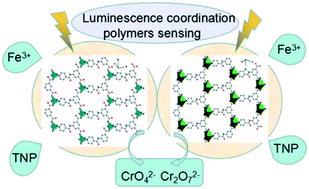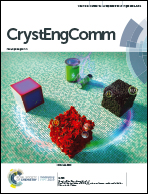Two 2D multiresponsive luminescence coordination polymers for selective sensing of Fe3+, CrVI anions and TNP in aqueous medium†
Abstract
Two luminescence coordination polymers (CPs) formulated as {[Zn(L)(H2O)2]·H2O}n (1) and {[Cd(L)(H2O)2]·4H2O}n (2) are successfully prepared by solvothermal reactions between the corresponding metal(II) ions and 5-(4-pyridylamino)isophthalic acid (H2L). Crystallographic studies reveal that 1 and 2 exhibit similar 2D honeycomb layer networks, but have different numbers of lattice water molecules. The layers are connected through hydrogen bonds to give 3D supramolecular frameworks. CPs 1 and 2 possess coordinated water molecules and uncoordinated oxygen atoms as well as electron-rich amide groups, which are easy to recognize diverse analytes. Moreover, they show considerable stability in aqueous systems with a broad pH range from 3 to 12. Luminescence sensing experiments indicate that they can be regarded as highly sensitive sensors for detecting Fe3+ ions, CrVI anions (CrO42− and Cr2O72−) and 2,4,6-trinitrophenol (TNP) through luminescence quenching. In addition, the mechanisms for the luminescence response of CPs 1 and 2 towards Fe3+ ions, CrVI anions and TNP have been investigated in detail. Besides, CPs 1 and 2 represent two very good examples of versatile Zn/Cd-CP probes capable of sensing Fe3+ ions, CrVI anions and TNP.



 Please wait while we load your content...
Please wait while we load your content...